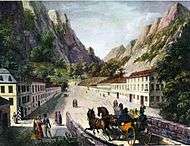Băile Herculane
| Băile Herculane | ||
|---|---|---|
| Town | ||
|
Bǎile Herculane seen from a mountaintop | ||
| ||
 Location of Băile Herculane | ||
| Coordinates: 44°52′43″N 22°24′51″E / 44.87861°N 22.41417°ECoordinates: 44°52′43″N 22°24′51″E / 44.87861°N 22.41417°E | ||
| Country |
| |
| County | Caraș-Severin County | |
| Status | Town | |
| Government | ||
| • Mayor | Cristian Miclău (PNL) | |
| Area | ||
| • Total | 105.48 km2 (40.73 sq mi) | |
| Population (2011) | ||
| • Total | 5,008 | |
| • Density | 47.5/km2 (123/sq mi) | |
| Time zone | EET (UTC+2) | |
| • Summer (DST) | EEST (UTC+3) | |
| Climate | Cfb | |
| Website | Official site | |
Băile Herculane (Latin: Aqua Herculis; German: Herkulesbad; Hungarian: Herkulesfürdő; Czech: Herkulovy Lázně, Turkish: Lazarethane) is a town in Romanian Banat, in Caraș-Severin County, situated in the valley of the Cerna River, between the Mehedinți Mountains to the east and the Cerna Mountains to the west, elevation 168 meters. Its current population is approximately 5,000. The town administers one village, Pecinișca (Hungarian: Pecsenyeska; from 1912 to 1918 Csernabesenyő).
History
| Historical population | ||
|---|---|---|
| Year | Pop. | ±% |
| 1956 | 1,656 | — |
| 1966 | 2,456 | +48.3% |
| 1977 | 3,835 | +56.1% |
| 1992 | 6,340 | +65.3% |
| 2002 | 6,051 | −4.6% |
| 2011 | 5,008 | −17.2% |
| Source: Census data | ||
The spa town of Băile Herculane has a long history of human habitation. Numerous archaeological discoveries show that the area has been inhabited since the Paleolithic era. The Peștera Hoților (Cave of the Thieves), contains multiple levels, including one from the Mousterian period, one from the Mesolithic period (late Epigravettian) and several from the later Neolithic periods.
Legend has it that the weary Hercules stopped in the valley to bathe and rest. Unearthed stone carvings show that visiting Roman aristocrats turned the town into a Roman leisure center. Six statues of Hercules from the time have been discovered. A bronze replica of one of them, molded in 1874, stands as a landmark in the town center. Austrian and Ottoman troops clashed here after the Ottoman victory in the battle of Mehadia on 30 August 1788.[1] The Ottomans won the skirmish, took the town on 7 September 1788 and advanced to Caransebeș. It was retaken by the Austrians at the end of September 1789.
The modern spa
In modern times, the spa town has been visited for its supposedly natural healing properties: hot springs with sulfur, chlorine, sodium, calcium, magnesium and other minerals, as well as negatively ionized air. Before World War II, when the first modern hotel was built (i.e. H Cerna, 1930) it remained a popular destination with Western Europeans.[2] During the Communist rule, mass tourism facilities were built, such as the 8- to 12-storied concrete hotels Roman, Hercules A, Hercules B, Afrodita, Minerva, Diana, UGSR, etc. which dominate the skyline. It was visited by all kinds of people, but was especially popular with employees and retirees, who would spend their state-allotted vacation vouchers there, hoping to improve their health. Today, they share the town with a younger crowd. New privately owned pensions and hotels appeared after 1989, along the Cerna/Tiena river banks, spread from the train station to the end of the hydroelectrical dam. Some of the Austro-Hungarian era buildings are derelict for the time being, including many of the baths, because of post-communism property related issues.
Image gallery
 Spa
Spa Statue of Hercules
Statue of Hercules Cerna Hotel
Cerna Hotel Roman Hotel
Roman Hotel Culture house
Culture house Railway station
Railway station The town in 1824
The town in 1824
References
- ↑ http://f.eba.gov.tr/flippingbook/04-ansiklopediler/04-ansiklopediler-ansiklopediler-osmanli-tarihi-cilt-3/files/assets/basic-html/page138.html
- ↑ The fashionable crowds of the era are described at pp. 210-211 in "Between the Water and the Woods," by Patrick Leigh Fermor (Penguin Books, 1987)(ISBN 9780140094305).
External links
| Wikimedia Commons has media related to Băile Herculane. |
- (in Romanian) Băile Herculane


